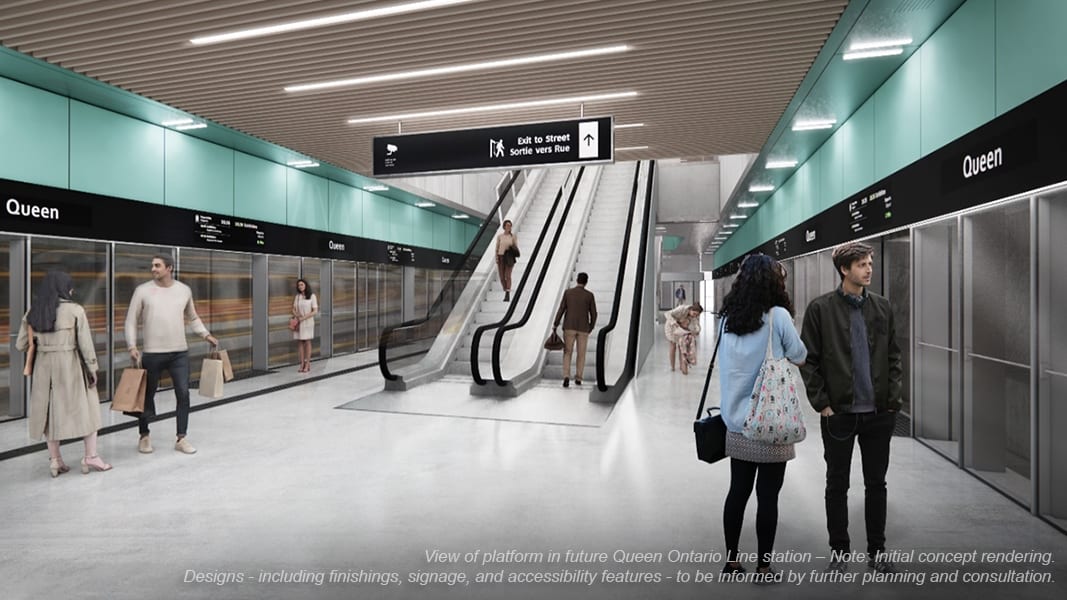Queen Street diversion starts May 1 for Ontario Line work
Queen Street will be closed to all but pedestrians between Bay and Victoria starting May 1.
Apr 11, 2023
Starting May 1, 2023, all vehicle traffic will be diverted off Queen Street from Bay Street to Yonge Street and from Yonge Street to Victoria Street for an estimated four and a half years – an important step forward in construction of Ontario Line’s future Queen Station.
With heavily built up infrastructure both above and underground in the area – particularly the TTC’s Line 1 and its existing Queen subway station – construction needs to take place in the roadway to safely and efficiently build the much-needed Ontario Line subway project.
Closing this section of street to vehicle traffic will expedite construction for the project by roughly one year compared to an approach with multiple partial closures. This means commuters can enjoy the benefits of the Ontario Line faster and with less disruption to the community. The full closure also provides much more predictability for people. Consistent access into and out of the downtown core will be maintained with modified streetcar service during construction.
“We’ve been working closely with our partners at the City of Toronto and the TTC to coordinate construction and keep people moving safely and efficiently,” says Malcolm MacKay, Metrolinx’s Ontario Line program sponsor.
A map showing more detail on the traffic diversion on Queen Street. (Metrolinx image)
While Queen Street will be closed to all vehicles, it will be open for pedestrians. Safe, effective detours and wayfinding will ensure that people living in, working in or visiting the area will still be able to access all their favourite shops, restaurants and cafés during the closure.
“It’s important to us to keep the area open for pedestrians and keeping businesses accessible,” says MacKay. “It’s especially important that it’s all done with safety as a top priority.”
Benefits of the Ontario Line
The future Ontario Line Queen Station is expected to be the line’s busiest - seeing almost 17,000 people during rush hour and connecting to 150,000 jobs in the area. It will also be a vital transfer hub for people wanting quick and easy transfers between the existing Line 1 subway, TTC surface routes and the Ontario Line.
Connections like the one at Queen Station are why the Ontario Line is expected to accommodate nearly 400,000 daily trips and reduce crowding on the TTC’s busy Line 1 by up to 15 per cent.
Keeping people moving
A plan developed by Metrolinx, the City of Toronto and the TTC includes building permanent detour infrastructure for the TTC’s 501 Queen streetcar route to keep Toronto moving during important Ontario Line construction.
This infrastructure – which is expected to be completed in 2024 – will also improve transit in the downtown core well after the Ontario Line is up and running by providing an alternate streetcar route when there are special events or road works taking place in the area.
The permanent streetcar detour tracks will run along Adelaide and Richmond streets, connecting via York Street and Church Street.
A map showing the details of the future TTC streetcar detour. (Metrolinx image)
Once watermain replacement work that is currently underway on Adelaide Street is completed, work will begin on the streetcar infrastructure upgrades needed on that part of the detour.
“We’ve been working closely with our partners on how to speed up delivery of the detour work on Adelaide,” explains MacKay.
Though the permanent detour will come later, the TTC will still provide continuous east-west streetcar service on the 501 streetcar as of May 1. During construction of the new detour tracks, existing streetcars will detour onto Dundas Street at McCaul Street in the west and Broadview Avenue in the east.
The TTC will also introduce additional bus service in this section of downtown, which will run westbound on Richmond Street and eastbound on King Street via Bay Street and Church Street. Westbound service will originate at Broadview Avenue and eastbound service will originate at Bathurst Street.
Working together
Coordinating construction in such a dense, urban area as Toronto is a must. That is why Metrolinx is partnering with the City, TTC, utility companies and others to ensure a coordinated approach to managing traffic impacts, establishing alternate transit routes, and giving people more predictability with trip planning.
Metrolinx will also be establishing a community liaison committee for this area, which will serve as a collaborative forum to come up with creative solutions and mitigation efforts to minimize impacts on businesses and communities. These types of working groups will be in place across the entire Ontario Line route.
For more information on the Ontario Line and construction happening on Queen Street, visit Metrolinx.com/OntarioLine
by Sara Wilbur Metrolinx communications senior advisor, subway program
